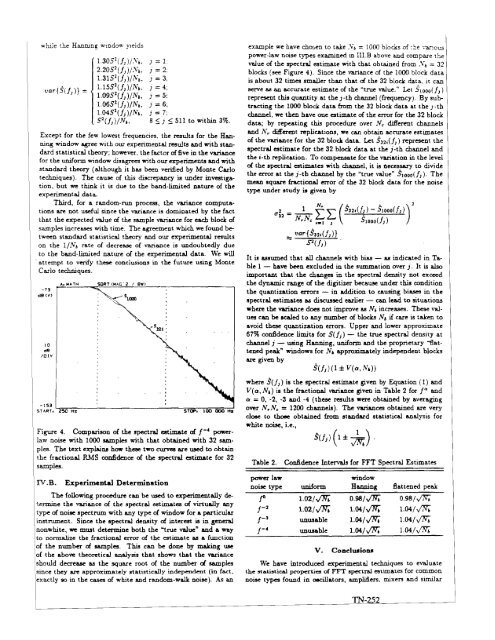NIST Technical Note 1337: Characterization of Clocks and Oscillators
NIST Technical Note 1337: Characterization of Clocks and Oscillators
NIST Technical Note 1337: Characterization of Clocks and Oscillators
You also want an ePaper? Increase the reach of your titles
YUMPU automatically turns print PDFs into web optimized ePapers that Google loves.
while the Hanning ""!Odo"" yIelds1.305 2 (f) )/.V b, 1==1:2.205 2 (/) )IN" j == 2:1.315 2 (/j )IN" j =: 3;1.155 2 (/) )/N" ] =: 4;1.095 2 (/))/N" J =: 5:1.065 2 (!i )/N" j =: 6;1.045 2 (/j )iN" j =: 7;5'2U))IN" 8 .$ j :s: 511 to within 3%.Except for the few lowest frequenci~. the results for the Hanningwindow agree with our experimental results <strong>and</strong> with st<strong>and</strong>ardstatistical theory; however. the factor <strong>of</strong> five in the variancefor the uniform window disagrees with our experiments <strong>and</strong> withst<strong>and</strong>ard theory (although it has been verified by Monte Carlotechniques). The cause <strong>of</strong> this di!lcrepancy is under investigation,but we think it is due to the b<strong>and</strong>-limited nature <strong>of</strong> theexperimental data.Third, for a r<strong>and</strong>om-IUD process, the variance computationsBJ'E not useful since the variance is domillated by the factthat the expected value <strong>of</strong> the sample variance for each block <strong>of</strong>sampl~ increases with time. The agreement which we found betweenst<strong>and</strong>ard statistical theory <strong>and</strong> our experimental resultson the liN. rate <strong>of</strong> decrease <strong>of</strong> variance is undoubtedly dueto the b<strong>and</strong>-limited nature <strong>of</strong> the experimental data. We will. a.ttempt to verify these conciusions in the future using MonteCarlo techniques.-7]de(V)'0"e/OIVA.IJlIATHexample we have cho~n to take .vb = 1000 blocks <strong>of</strong> :be va,.,;ouspower-law noise types examined m IlLS above <strong>and</strong> compare thevalue <strong>of</strong> the spectral estimate with that obtained from .\"6 = 32blocks (see Figure 4). Since the variance <strong>of</strong> the 1000 block datais about 32 times smaller than that <strong>of</strong> the 32 block data. it canserve as an accurate estimate <strong>of</strong> the "true value. ~ Let 5 1000 (f) )represent this quantity at the loth cha.n.nel (frequency). By subtractingthe 1000 block data from the 32 block data at the l-thcha.n.nel, we then have one estimate <strong>of</strong> the error for the 32 blockdata; by repeating this procedure over N c different cha.n.nels<strong>and</strong> N r clifi'erent repliCAtions, we can obtain accurate estimates<strong>of</strong> the variance for the 32 block data. Let 5 32 i (f) ) represent thespectral estimate for the 32 block data at the j-th cha.n.nel <strong>and</strong>the i-th repliCAtion. To compensate for the variation in the level<strong>of</strong> the spectral estimates with cha.n.nel, it is aecessary to dividethe error at the j-th cha.n.ne1 by the "true value~ 5 1000 (/)), Themean square fractional error <strong>of</strong> the 32 block data for the noisetype under study is given byIt is assumed that all channels with biM - as indicated in Table1 - have been excluded in the summation CfIIer j. It is alsoimportant that the changes in the spectral density not exceedthe dynamic range <strong>of</strong> the digitizer because under this conditionthe quantization errors - in addition to causing biases in thespectral estimates as discussed earlier - can lead to situationswhere the variance does not improve as N 6 increases_ These Vll.!ues can be sealed to any number <strong>of</strong> blocks N, if care is taken toavoid these quantization errors. Upper <strong>and</strong> lower approximate67% confidence limits for SUj) - the true spectral density atchannel j - using Hanning, uniform <strong>and</strong> the proprietary 'ilattenedpeak" windows for N 6 approximately independent blocksare given bys;~;~. L~=""H""Z--------------;-S"'TC=-., -1'""OO::::-:OOO=-:Ha-:-lFigure 4. Comparison <strong>of</strong> the spectral estimate <strong>of</strong> /-4 powerlawnoise with 1000 samples with that obtained with 32 samples.The text expwIUl how these two curves are used to obtainthe fractional RMS confidence <strong>of</strong> the spectral estimate for 32samples.IV.B.Experimental DeterminationThe following procedure can be used to experimentally determinethe VlUiance <strong>of</strong> the spectral estimates <strong>of</strong> virtually anytype <strong>of</strong> noise spectrum with any type <strong>of</strong> window for a particularinstrument. Since the spectral density <strong>of</strong> interest is in generalnonwhite, we must determine both the "true value" <strong>and</strong> a wayto nonnalize the fractional error <strong>of</strong> the estimate lila a function<strong>of</strong> the number <strong>of</strong> SIlmples. This can be done by making IJlIel<strong>of</strong> the above th~retical ane.lysis that shows that the varianceshould decrease as the square root <strong>of</strong> the number al samplesIsince they are approximately statistically indepf!Ildf!Ilt (in fut,lexa.ctly 90 in the ca.ses <strong>of</strong> white <strong>and</strong> r<strong>and</strong>om-waJ.k noise). As anwhere S(Ii) is the spectral estimate given by Equation (1) <strong>and</strong>V(a,N,) is the fractionalll!lriance given in Table 2 for fQ <strong>and</strong>Q = 0, ·2, -3 <strong>and</strong> -4 (these results were obtained by averagingover NrNc = 1200 channels). The variances obtained are veryclose to thoee obtained from st<strong>and</strong>ard statistical analysis forwhite noise, i.e.,Table 2.power lawConfidence Interval! for ITT Spectral Estimateswindownoise type uniform Hanning Battened peakr 1.02/,fN; 0.98/,fN; O.9S/v'N;/-2 l.02/..;'N; 1.04/,fN; 1.04/.;:v;r 3 unusable 1.04/ ,J'lV; 1.04/y'N;/-4 unusable 1.041,J'lV; l.04/v'NbV. CondlUioDJIWe have introduced experimental techniques to evaluatethe stati"tieal properties <strong>of</strong> FFT spectral estimates for commonnoise types found in oecillators, ampli£.ers. mixers <strong>and</strong> similarTN-252
















